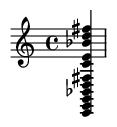Summary:
Dive deep into the Lydian Dominant scale (Lydian b7), the sound behind *The Simpsons* theme and countless jazz solos. This guide breaks down its theory, shows you how to build it, and provides practical examples and licks to help you master its unique, dreamy-yet-tense character in your own music.
Keywords:
Lydian Dominant, Lydian b7, scale, mode, music theory, composition, improvisation, harmony, jazz, modal interchange, altered dominant, melodic minor modes, Simpsons scale
Introduction:
Tired of the same old major and minor scales? The Lydian Dominant scale is your gateway to a world of sophisticated, colorful harmony. It masterfully blends the bright, uplifting feel of the Lydian mode with the raw tension of a dominant 7th chord. Often described as 'the sound of the future' in mid-century jazz, this scale is a secret weapon for composers and improvisers in jazz, film scoring, and even progressive rock. Let's unlock its secrets.
What is the Lydian Dominant Scale?
The Lydian Dominant scale is a seven-note scale with a unique and powerful sound. Its signature character comes from having both a raised fourth and a lowered seventh degree.
The scale formula is: 1 - 2 - 3 - #4 - 5 - 6 - b7
The intervals from the root are: Root, Major Second, Major Third, Augmented Fourth, Perfect Fifth, Major Sixth, and Minor Seventh.
There are two primary ways to understand its origin:
- As the 4th Mode of the Melodic Minor Scale: This is the most common theoretical derivation. If you take any Melodic Minor scale and start playing it from its fourth degree, you get the Lydian Dominant scale. For example, the G Melodic Minor scale is G-A-Bb-C-D-E-F#. If you start on the fourth note (C) and play the same notes, you get C-D-E-F#-G-A-Bb, which is C Lydian Dominant.
- As an Altered Lydian or Mixolydian Scale: You can think of it as a Lydian scale (1, 2, 3, #4, 5, 6, 7) with a flatted seventh, or as a Mixolydian scale (1, 2, 3, 4, 5, 6, b7) with a raised fourth. The combination of the bright #4 and the tense b7 is what gives the scale its name and distinctive sound.
Building Blocks: The Scale and Its Chord
Let's look at the C Lydian Dominant scale. Notice the F#, which is the #4, and the Bb, which is the b7.
C Lydian Dominant Scale

This scale is the perfect choice to play over a dominant 7th chord with a sharp 11th, such as C7(#11) or C9(#11). The #4 of the scale becomes the #11 of the chord. Here's a common voicing for C9(#11), which contains all the characteristic notes.
The Associated Chord: C9(#11)

How and Where to Use the Lydian Dominant Scale
The Lydian Dominant scale is more than a theoretical concept; it's a practical tool for adding color and tension. Here are its most common applications:
- The V7 Chord in a Major Key II-V-I: In a progression like Dm7 - G7 - Cmaj7, using G Lydian Dominant (G-A-B-C#-D-E-F) over the G7 chord creates a sophisticated tension. The C# (#4) adds a beautiful dissonance that can resolve gracefully to either C (the root of the Cmaj7 chord) or D (the 9th).
- Tritone Substitution: This scale shines when used with tritone substitution. For example, instead of G7 going to Cmaj7, a jazz musician might substitute Db7. The G Lydian Dominant scale works beautifully over this Db7, creating a lush, altered sound that still resolves perfectly to Cmaj7.
- Non-Resolving Dominants: In modal jazz or funk, dominant chords often create a static harmonic texture rather than resolving. The Lydian Dominant scale is perfect for improvising over these vamps, providing melodic interest without implying a resolution that isn't coming.
- The "Simpsons" Sound: The iconic opening theme from *The Simpsons*, composed by Danny Elfman, features a melody built on the Lydian Dominant scale. The phrase sung over the title card ("The Simp-sons") uses the notes C, F#, G, A, and E against a C dominant chord, perfectly capturing the scale's quirky, memorable character.
Practical Example: Lydian Dominant Lick over a II-V-I
Here is a short melodic phrase using the G Lydian Dominant scale over a G7 chord in a standard II-V-I progression. Listen for the C# (#4) in the second measure.
Pioneers and Modern Usage
While its roots can be found in the work of early 20th-century composers like Béla Bartók, the Lydian Dominant scale was codified and popularized by theorist George Russell in his groundbreaking "Lydian Chromatic Concept of Tonal Organization." This work heavily influenced jazz musicians seeking to break free from traditional chord-scale relationships.
Jazz giants like Herbie Hancock, Wayne Shorter, and Joe Henderson frequently used its unique color in their improvisations and compositions. In modern times, its sound is a staple for film and television composers like Danny Elfman and John Williams, who use it to evoke feelings of magic, wonder, and epic adventure.
Key Characteristics & Listening Guide
- Dreamy Tension: The scale's magic lies in its conflict. The #4 pulls upward with a bright, "Lydian" sound, while the b7 pulls downward with a bluesy, "dominant" tension.
- The Double Tritone: It uniquely contains two tritones from the root: the one between the root and the #4 (e.g., C to F#) , and the classic dominant 7th tritone between the 3rd and b7 (e.g., E to Bb). This double dose of dissonance is the source of its rich harmonic potential.
Listening Guide:
- "The Simpsons Main Title Theme" by Danny Elfman: The most famous example!
- "Maiden Voyage" by Herbie Hancock: The piano and horn melodies float over non-resolving dominant chords, often implying a Lydian Dominant sound.
- "Inner Urge" by Joe Henderson: The melody of this advanced jazz standard is a masterclass in using notes from melodic minor modes, including Lydian Dominant.
Conclusion:
The Lydian Dominant scale isn't just a theoretical curiosity; it's a practical tool for adding depth, surprise, and sophistication to your music. It empowers you to move beyond basic harmony and into a world of richer textures. Start by experimenting with it over a simple II-V-I progression. Play the G Lydian Dominant scale over the G7 chord and listen to how that C# adds a new dimension before resolving to C Major. Embrace the beautiful dissonance and unlock a new level of harmonic expression.
References:
Levine, M. (1995). The Jazz Theory Book. Sher Music Co.
Russell, G. (2001). The Lydian Chromatic Concept of Tonal Organization. Concept Publishing Company.
Kostka, S., Payne, D., & Almén, B. (2017). Tonal Harmony. McGraw-Hill Education.
Wikipedia contributors. (2024, May 1). Acoustic scale. In Wikipedia, The Free Encyclopedia. Retrieved 18:00, May 17, 2025, from https://en.wikipedia.org/wiki/Acoustic_scale
